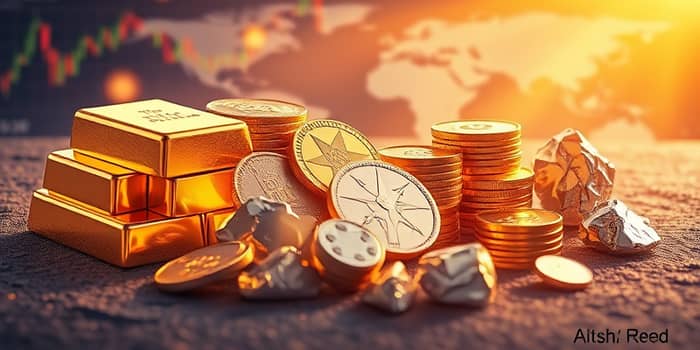Investing in precious metals has long captured the imagination of both seasoned investors and newcomers alike. Amid shifting economic tides, metals like gold, silver, platinum, and palladium offer a distinct appeal as tangible assets that can provide stability and diversification when traditional markets falter.
Why Precious Metals Matter in Today’s Economy
Precious metals serve as a cornerstone for many investors seeking protection against inflation and currency risks. Unlike paper assets, their value often moves independently of equities and bonds, making them an essential component of a balanced portfolio.
During economic downturns or times of geopolitical upheaval, metals can appreciate in value. In 2022, for example, global equities and bonds suffered double-digit losses, while silver rose 6.3%, platinum jumped 12.2%, and gold climbed modestly by 0.4%. These historical trends underscore why metals are prized for their resilience.
Main Types of Precious Metals and Their Unique Benefits
Each precious metal brings its own characteristics to an investor’s toolkit. Understanding these distinctions is key to selecting the right combination for your financial goals.
- Gold: The most liquid and widely held metal, renowned as a long-term store of value.
- Silver: More volatile than gold, but benefits from strong industrial demand in electronics and solar panels.
- Platinum and Palladium: Rarer than gold and silver; prices correlate heavily with automotive catalyst usage, leading to higher price swings.
How to Invest in Precious Metals
Investors can gain exposure to precious metals through a variety of vehicles, each offering different trade-offs in cost, liquidity, and convenience.
- Physical Metals: Bars, coins, and bullion give you direct ownership but involve storage and insurance expenses.
- ETFs and Mutual Funds: Provide easy access without the hassle of handling physical assets, though they carry management fees.
- Futures Contracts: Offer leveraged exposure but introduce complexity and elevated risk unsuitable for many individuals.
- Mining Stocks: Represent shares in extraction companies, giving potential dividends alongside metal price movements.
Advantages of Holding Precious Metals
Including precious metals in your portfolio can deliver multiple strategic benefits when executed thoughtfully.
- They act as a hedge against economic uncertainty, often rising when other assets decline.
- They help diversify your investment portfolio, reducing overall volatility and smoothing returns.
- They possess intrinsic, tangible value you can hold, free from counterparty default or credit risk.
Assessing the Risks and Drawbacks
No investment is without downsides, and precious metals are no exception. Perhaps the most prominent drawback is that metals do not generate income; they yield no dividends or interest. This means the only path to profit is through price appreciation.
Price volatility can be severe, driven by shifts in industrial demand, mining output, and investor sentiment. Additionally, physical holdings incur storage, insurance, and transaction fees that can reach up to 5% of the purchase price, eating into returns over time.
Summary Table: Pros vs. Cons
Strategic Considerations for Building a Precious Metals Allocation
Determining your optimal metals allocation starts with evaluating your risk tolerance and goals. Common wisdom suggests dedicating between 5% and 10% of a diversified portfolio to precious metals, though that figure can vary based on individual circumstances.
Decide whether you seek metals primarily as an inflation hedge, a crisis buffer, or a speculative play. Your chosen investment vehicle should match your liquidity needs and your willingness to manage physical holdings or pay ongoing fees for ETFs and accounts.
Current Market Trends and Future Outlook
Interest in precious metals typically surges when inflation is high, currencies weaken, and equities stumble. Recent global events, from supply chain disruptions to geopolitical tensions, have reignited demand for both physical and paper-based metal investments.
Looking ahead, advances in green technology—like electric vehicles requiring platinum and palladium catalysts—could further influence metal prices. Meanwhile, central bank purchases of gold remain a key driver of long-term value, underscoring the enduring role of precious metals in global finance.
Conclusion: Making an Informed Decision
Investing in precious metals can be a powerful way to reduce overall portfolio volatility and protect against unforeseen economic shocks. Yet, these assets are not a cure-all and come with their own set of risks and costs.
Before allocating funds, understand all associated costs, clarify your investment horizon, and establish an exit strategy. By combining prudent research with a clear sense of purpose, you can harness the unique strengths of precious metals while maintaining a balanced, forward-looking portfolio.
References
- https://www.td.com/ca/en/personal-banking/products/personal-investing/precious-metals-gold-silver-platinum/precious-metals-considerations
- https://www.investopedia.com/articles/basics/09/precious-metals-gold-silver-platinum.asp
- https://money.com/investing-in-precious-metals/
- https://www.securities.nd.gov/news/investor-advisory-precious-metals-and-coin-investments
- https://shopglobalcoin.com/blogs/blog/building-a-strong-precious-metals-investment-portfolio-tips-and-strategies
- https://firstlienheloc.com/investing-in-precious-metals-pros-cons-and-how-to-get-started/
- https://www.fidelity.com/learning-center/trading-investing/how-to-buy-gold
- https://www.aberdeeninvestments.com/en-us/investor/insights-and-research/precious-metals-place-in-a-portfolio










